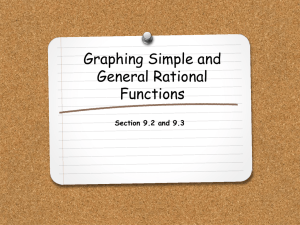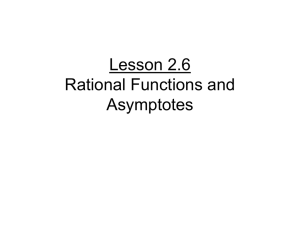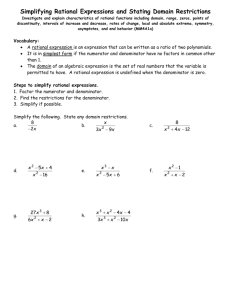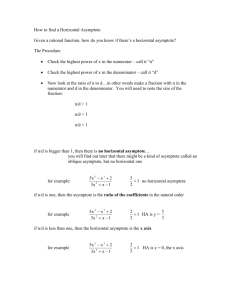graph
advertisement
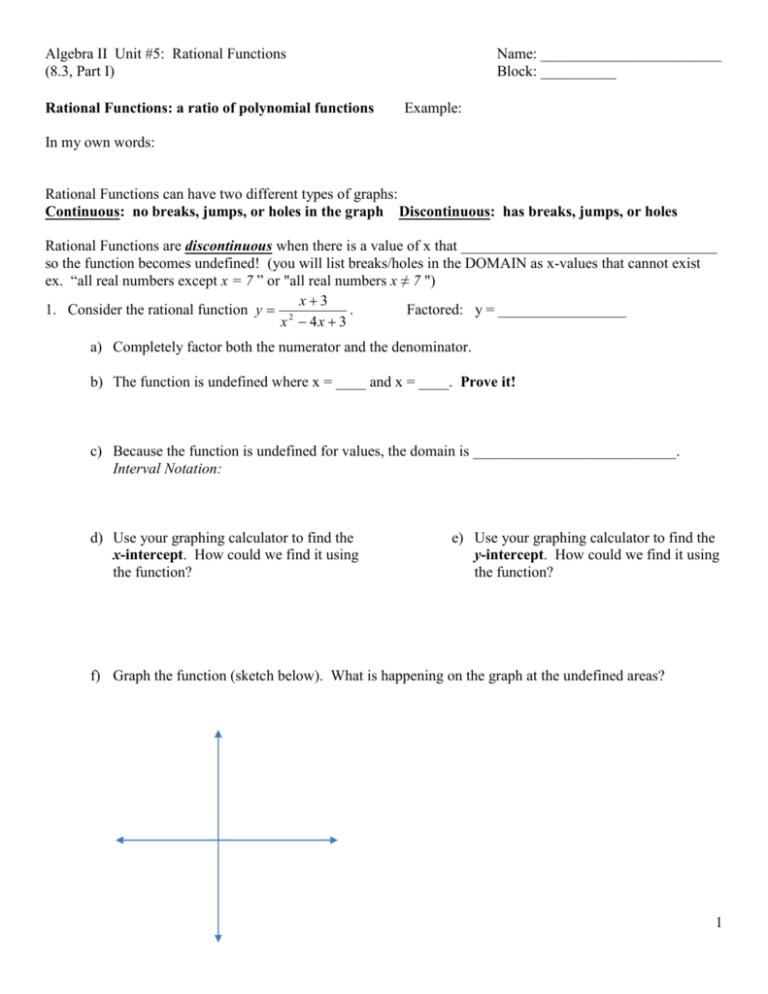
Algebra II Unit #5: Rational Functions (8.3, Part I) Rational Functions: a ratio of polynomial functions Name: ________________________ Block: __________ Example: In my own words: Rational Functions can have two different types of graphs: Continuous: no breaks, jumps, or holes in the graph Discontinuous: has breaks, jumps, or holes Rational Functions are discontinuous when there is a value of x that __________________________________ so the function becomes undefined! (you will list breaks/holes in the DOMAIN as x-values that cannot exist ex. “all real numbers except x = 7 ” or "all real numbers x ≠ 7 ") x3 1. Consider the rational function y 2 . Factored: y = _________________ x 4x 3 a) Completely factor both the numerator and the denominator. b) The function is undefined where x = ____ and x = ____. Prove it! c) Because the function is undefined for values, the domain is ___________________________. Interval Notation: d) Use your graphing calculator to find the x-intercept. How could we find it using the function? e) Use your graphing calculator to find the y-intercept. How could we find it using the function? f) Graph the function (sketch below). What is happening on the graph at the undefined areas? 1 2. Consider the rational function y 1 . x 16 2 Factored: y = _________________ a) Completely factor both the numerator and the denominator. b) The function is undefined where x = ____ and x = ____. Prove it! c) The domain is ______________________________. Interval Notation: _____________________ d) Why is there no x-intercept? How does the function rule show this? How does the graph show it? e) Find the y-intercept using the function rule. Show your work. f) Graph the function. What is happening on the graph at the undefined areas? 3. Consider the rational function y x2 1 . x 3 9x Factored: y = _________________ a) Completely factor both the numerator and the denominator. b) The function is undefined where x = ____ and x = ____. c) The domain is ______________________________. Interval Notation: _____________________ d) Graph the function. What is happening at the undefined values? e) Find the x-intercept(s). f) Find the y-intercept. 2 Non-Removable Discontinuities: a vertical asymptote. Removable Discontinuities: (a.k.a. a “hole”) – a point on the graph that does not exist due to the canceling of factors from the denominator. This value of x makes the function undefined; therefore, you would identify the point (x, f(x)) as a hole in the graph. (plug the x value back into the simplified form to find the y coordinate.) To graph the function, use the simplified form of the function and show a “hole” as an open circle. x 2 3x 4 . x4 a) For which value of x is the function undefined? Why? 2. Consider the rational function f ( x) Therefore the domain is: __________________ b) Completely factor both the numerator and the denominator below. What happens when you simplify the function? c) Graph the function and make a sketch. What is happening at x = 4 (look in the table) d) What shape is the graph? Why is this the shape? e) The factored function: f(x) = __________________ has a REMOVABLE discontinuity at x = ___. The coordinates of the “hole” are ( _____, _____). 3. Simplify each rational function. Then find all discontinuities. Write the equations for any vertical asymptotes (non-removable) and the ordered pair for all holes (removable) for each function. a) y 5 x x2 1 b) y x2 x2 4 c) y d) y 2x 6 x2 9 e) y 5x x x f) 2 y x2 4 x2 4 x 2 3x 4 x2 4x 5 3 *While the graph of a rational function can have any number of vertical asymptotes, it can have no more than one horizontal asymptote. **To find the horizontal asymptote of the graph of a rational function, compare the ___________________ of the numerator m to the __________________ of the denominator n. 4. Use the rules above to determine the horizontal asymptote for the rational functions below. a) y 2x x3 b) y x2 x2 9 c) y d) y 2x5 3 7x5 1 e) y 1 4x 3 y f) x 2 2x 3 x2 x 3 3x 2 1 8x 4 g) Write your own rational function for each requirement. Then identify the equation for the H.A.. #1) No Horizontal Asymptote: #2) A positive horizontal asymptote, denominator is 10x2 #3) A negative horizontal asymptote #4) A Horizontal asymptote at y = 0 4 5. Graph the rational function y 4 . x 6x 5 2 Step 1: Find the horizontal asymptote, if it exists. Step 2: Find the vertical asymptote(s). a) Factor the numerator and/or denominator if possible. b) Set the denominator equal to zero. Solve for x. c) Vertical Asymptotes x = ______ and x = ________. Step 3: Find the x –intercept(s). (Set the numerator equal to zero.) Step 4: Find the y-intercept(s). (Let x = 0 and solve for y.) Step 5: Graph the function and all key features. Make a t-chart of exact points on both sides of the asymptotes. 6. Sketch the graph of the rational funtion y x2 4 . Identify all key feature that exist! 3x 6 Be sure to show all work. Horizontal Asymptote: Vertical Asymptote: hole: x-intercept: y-intercept: 5 (8.1-8.3) Strategies for Graphing a Rational Function 𝑓(𝑥) = 𝑝(𝑥) 𝑞(𝑥) 1. Factor the numerator and the denominator. 2. Determine the domain of the rational function; the domain will be all real numbers except the zeros of the denominator. 3. Reduce the function by cancelling out any factors that are in both the top and the bottom. 4. Find all x-intercepts. In the reduced form of the function, set each factor in the numerator equal to zero and solve, those are your x-intercepts. 5. Find the y-intercept if any Plug zero in for x and solve for y. (Hint: Use the un-factored form of the function, the y-intercept will be the constant on top divided by the constant on bottom.) 6. Find the Hole(s). Holes occur when a factor in the numerator is the same as a factor in the denominator. Set this factor equal to zero to find the x-value of the hole. Put the x-value into the reduced form of the equation and solve to find the y-value of the hole. Graph the hole at point the (x,y) with an open dot. 7. Find all vertical asymptotes. The vertical asymptotes are all the zeros of the denominator in the reduced form of the function. The equation of the vertical asymptotes is x =p, where p is a zero of the denominator. 8. Find the horizontal or oblique asymptote. a) If the degree of the top is less than the degree of the bottom. Then your HA will be 𝑦 = 0. 𝑎 b) If the degrees are the same, then 𝑦 = 𝑏 , where a and b are the leading coefficients of the numerator and the denominator. c) If the degree is the top is greater than the degree of the bottom, then there is an oblique asymptote. **To find the oblique asymptote, use polynomial long division. The asymptote will be the quotient. (you can ignore the remainder!) 9. Sketch the graph. (Make sure you plot 2 exact points on both sides of all the vertical asymptotes to see how the graph behaves! – make a t-chart to find these ordered pairs!) Graphs of reciprocal functions look different: if it is in the form 𝒚 = 𝒂 𝒙−𝒉 +𝒌 Then h shifts horizontally and your vertical asymptote is at x = h Then k shifts vertically, and your horizontal asymptote is at y = k If a > 1 the graph is stretched, if 0 < a < 1 the graph is compressed If a is negative, the graph is reflected across the x- axis 6


